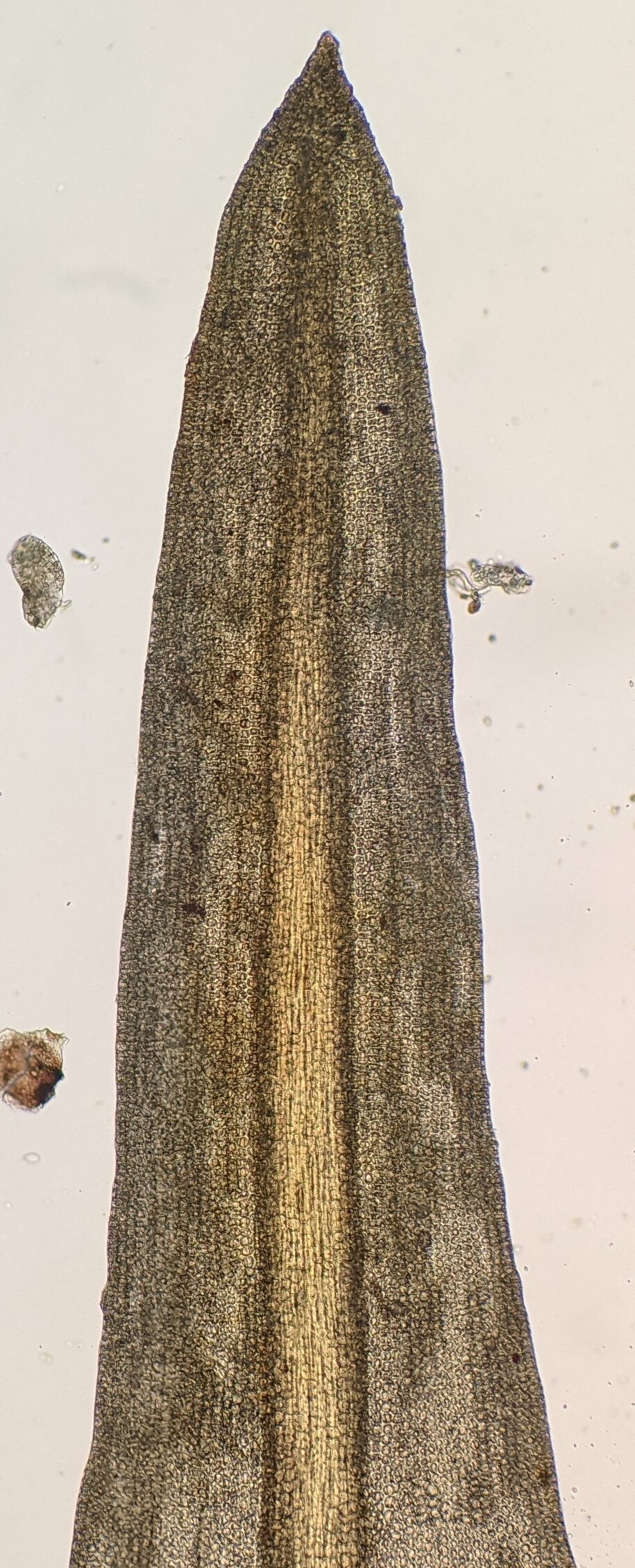Ptychomitriaceae
Autoicous, possibly rarely dioicous (not in Victoria). Asexual reproduction rarely by gemmae on branched axillary filaments (not in Victoria). Cushions or tufts on rocks or soil, rarely on trees (not in Victoria). Stem erect or creeping, simple or forked, covered in brown rhizoids, rhizoids restricted to base or glabrous; central strand present. Leaves arranged around stem facing all directions, monomorphic, erect, erect- to wide-spreading, or rarely appressed (not in Victoria) when moist, erect and appressed, crispate or convolute when dry; apex acuminate, acute, obtuse, or cucullate, sometimes with a hairpoint (not in Victoria) or hyaline apiculus (not in Victoria); costa subpercurrent, percurrent or excurrent (not in Victoria); margins entire to serrate, plane, recurved, or involute (not in Victoria), without a border; laminal cells oblate (not in Victoria), rhombic, or quadrate to rectangular, unistratose or bistratose in patches, smooth or slightly papillose (not in Victoria); alar cells not differentiated. Acrocarpous. Capsules erect, symmetric or slightly curved (not in Victoria), exserted or immersed (not in Victoria), operculate, with an annulus. Calyptra mitrate, plicate, lobed at base, glabrous. Operculum rostrate. Peristome a single series of 16 teeth, divided into 2 or 3 segments, irregularly perforate, entire (not in Victoria), or rarely absent (not in Victoria).
Worldwide except Antarctica, with eight genera and 62 species; two genera and four species in Victoria.
The circumscription of Ptychomitriaceae adopted here follows Fedosov et al. (2017), which includes Brachydontium, that has otherwise been placed in the Seligeriaceae (e.g. Schimper 1855; Goffinet et al. 2008) or in its own family (e.g. Schimper 1860). In chloroplast DNA phylogenies, Brachydontium was the closest relative to the genera of Ptychomitriaceae under the circumscription of Hernández-Maqueda et al. (2008), which included Ptychomitrium and two overseas genera previously placed in the Grimmiaceae. Campylostelium, which had been included in the Ptychomitriaceae, but recognised in its own family by Hernández-Maqueda et al. (2008), is also closely related and included in Ptychomitriaceae by Fedosov et al. (2017). Inclusion of all these genera in Ptychomitriaceae avoids recognising several monotypic families that have fewer differences between them than between subfamilies in the closely related Grimmiaceae and under this circumscription the Ptychomitriaceae all have a combination of being autoicous, and having mitrate calyptrae and a differentiated annulus (Fedosov et al. 2017). Brachydontium differs from the Seligeriaceae in several features including having striate rather than smooth capsules, a mitrate calyptra that is lobed at the base, and a differentiated annulus (Fedosov et al. 2017).
 Spinning
SpinningFedosov, V.; Fedorova, A.; Ignatova, E. (2017). On the taxonomic position of the genera Brachydontium Fürnr. and Campylostelium Bruch & Schimp. (Bryophyta Grimmiales). Journal of Bryology 39: 161–170.
Goffinet, B.; Buck, W.R.; Shaw, A.J. (2008). Morphology and classification of the Bryophyta, in Goffinet, B. & Shaw, A.J. (eds.), Bryophyte Biology 2nd edition, pp. 55–138. Cambridge University Press, Cambridge, UK.
Hernández-Maqueda, R.; Quandt, D.; Werner, O.; Muñoz, J. (2008). Phylogeny and classification of the Grimmiaceae/Ptychomitriaceae complex (Bryophyta) inferred from cpDNA. Molecular Phylogenetics and Evolution 46: 863–877.
Schimper, W.P. (1855). Corollarium Bryologiae Europaeae conspectum diagnosticum familiarum generum et specierum, adnotationes novae atque emendations complectens. E. Schweizerbart, Stuttgart.
Schimper, W.P. (1860). Synopsis Muscorum Europaeorum. E. Schweizerbart, Stuttgart.


